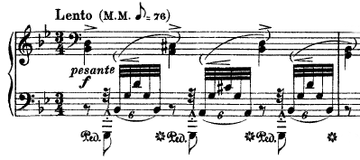Transcendental Étude No. 6 (Liszt)
Franz Liszt's Transcendental Étude No. 6 in G minor "Vision" is the sixth of his twelve Transcendental Études. It is a study of the extensions of the hand, hands moving in opposite directions, arpeggiated double notes, and tremolos.

The first bar of the Transcendental Étude No. 6
It is one of the easiest études out of Liszt's 12 Transcendental Études, though the beginning of the piece can be quite troublesome if it is played as directed: completely with the left hand (linked hand in the second edition [Dover]). It would require large stretches and dexterous leaps if done so.
Visual image
The visual image of this piece is a funeral. The middle section's wild octaves and rapidly climbing and descending arpeggios are filled with exaltation (as the original notes Franz Liszt scripted).
gollark: If the phone was on and receiving calls, would it not be interacting with the towers *anyway*?
gollark: Also my old HDD somewhere.
gollark: Can printers ever really be useful though?
gollark: The closest thing would be "dado".
gollark: Routing failure of some kind, which they can't fix remotely because they cannot communicate with the routers, and which also stopped them getting into the buildings.
External links
- Transcendental Études: Scores at the International Music Score Library Project (IMSLP)
This article is issued from Wikipedia. The text is licensed under Creative Commons - Attribution - Sharealike. Additional terms may apply for the media files.